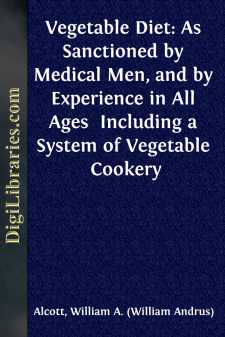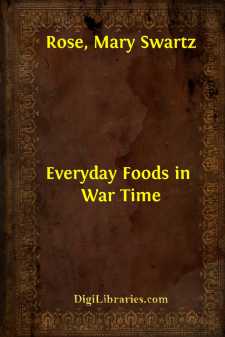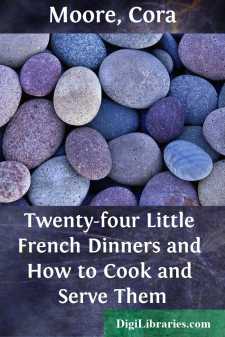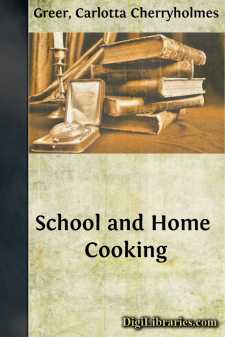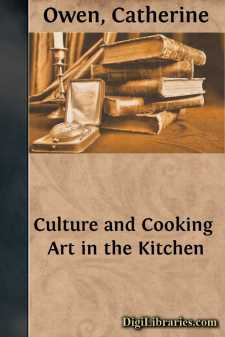Cooking
- General 70
- History 1
- Reference 10
- Regional & Ethnic 3
- Vegetarian 10
Cooking Books
Sort by:
PREFACE The following volume embraces the testimony, direct or indirect, of more than a hundred individuals—besides that of societies and communities—on the subject of vegetable diet. Most of this one hundred persons are, or were, persons of considerable distinction in society; and more than fifty of them were either medical men, or such as have made physiology, hygiene, anatomy, pathology,...
more...
by:
A. G. Payne
INTRODUCTION. We wish it to be distinctly understood at starting, that the present work is purely a cookery-book, written on the principles generally adopted by vegetarians; and as, until quite recently, there seemed to be in the minds of many some doubt as to the definition of vegetarianism, we will quote the following explanation from the head of the report of the London Vegetarian Society:—“The...
more...
by:
Mary Swartz Rose
CHAPTER I THE MILK PITCHER IN THE HOME (Reprinted from The Farmer's Wife, by permission of the Webb Publishing Company.) There is a quaint old fairy tale of a friendly pitcher that came and took up its abode in the home of an aged couple, supplying them from its magic depths with food and drink and many other comforts. Of this tale one is reminded in considering the place of the milk pitcher in...
more...
by:
Cora Moore
THE BUGBEAR OF AMERICAN COOKERY—MONOTONY It is as strange as it is true that with the supplies that have lately proved sufficient to feed a world to draw upon the chief trouble with American cookery is its monotony. The American cook has a wider variety of foods at his command than any other in the world, yet in the average home how rarely is it that the palate is surprised with a flavor that...
more...
by:
Various
PREFACE The recipes in this little book have been sent by Belgian refugees from all parts of the United Kingdom, and it is through the kindness of these correspondents that I have been able to compile it. It is thought, also, that British cooking may benefit by the study of Belgian dishes. The perfect cook, like Mrs. 'Arris or the fourth dimension, is often heard of, but never actually found, so...
more...
PREFACE School and Home Cooking is a text which can be placed in the hands of the pupils and used by them as a guide both in the school and home. Its use eliminates note-taking (which in reality is dictation) and thus saves much time. The psychological method of education, which treats first of material within the experience of the beginner and with that as a basis develops new material to meet the...
more...
by:
Edith Thomas
CHAPTER I. MARY'S LETTERS RECEIVED AT CLEAR SPRING FARM. One morning in early spring, John Landis, a Pennsylvania German farmer living in Schuggenhaus Township, Bucks County, on opening his mail box, fastened to a tree at the crossroads (for the convenience of rural mail carriers) found one letter for his wife Sarah, the envelope addressed in the well-known handwriting of her favorite niece, Mary...
more...
by:
Unknown
PENNSYLVANIA Dutch COOKERY In 1683 the Plain Sects began to arrive in William Penn’s Colony seeking a land of peace and plenty. They were a mixed people; Moravians from Bohemia and Moravia, Mennonites from Switzerland and Holland, the Amish, the Dunkards, the Schwenkfelds, and the French Huguenots. After the lean years of clearing the land and developing their farms they established the peace and...
more...
by:
Various
MY PET RECIPES TRIED and TRUE CONTRIBUTED BY THE LADIES AND FRIENDSOF ST. ANDREW'S CHURCHQUEBEC "We may live without poetry, music and art; We may live without conscience, and live without heart; We may live without friends; we may live without books; But civilized man cannot live without cooks."—Owen Meredith. QUEBEC "DAILY TELEGRAPH" PRINTING HOUSE 1900 Rhymes to Remember......
more...
by:
Catherine Owen
a few preliminary remarks Alexandre Dumas, père, after writing five hundred novels, says, "I wish to close my literary career with a book on cooking." And in the hundred pages or so of preface—or perhaps overture would be the better word, since in it a group of literary men, while contributing recondite recipes, flourish trumpets in every key—to his huge volume he says, "I wish to be...
more...


